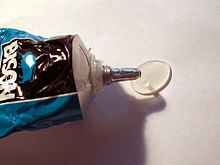

 | This is the user sandboxofFeicanews. A user sandbox is a subpage of the user's user page. It serves as a testing spot and page development space for the user and is not an encyclopedia article. Create or edit your own sandbox here. Other sandboxes: Main sandbox | Template sandbox Finished writing a draft article? Are you ready to request review of it by an experienced editor for possible inclusion in Wikipedia? Submit your draft for review! |
Adhesive bonding is a joining technique used in the manufacture of a wide range of products. Along with welding and soldering, adhesive bonding is one of the basic joining processes. In this technique, components are bonded together using adhesives. The broad range of types of adhesives available allows numerous materials to be bonded together in products as diverse as vehicles, mobile phones, personal care products, buildings, computers and medical devices.
An adhesive can be defined as a substance that causes two surfaces to stick together. By this definition, the earliest “adhesive” could be considered to have been developed three billion years ago, when primordial cells produced a tacky outer membrane allowing them to stick to adjacent cells. The first use of adhesives by humans can be dated to around 220,000 B.C., when tar from birch tree bark was used to glue stone arrowheads to a shaft[1]. For more examples of the history of gluing, see Adhesive.

According to the definition of EN 923: “Adhesives. Terms and definitions”, adhesives are non-metallic substances capable of joining materials by surface bonding (adhesion), with a bond possessing adequate internal strength (cohesion)”. The adhesive forms the connecting element between the two joined parts, which would not stick together without it. Adhesives can be grouped by chemistry, by application, or by the reaction mechanism.
According to IUPAC, adhesion is the “process of attachment of a substance to the surface of another substance”. Interactions between the adhesive and substrate have a very short range of less than one nanometre. Therefore, good wetting of the materials to be joined by the adhesive in its liquid state is required to produce a high quality bond. In addition to the wetting ability, the adhesive and substrate must have compatible molecular groups so that interaction between the adhesive and substrate can take place and thus achieve adhesion.
The adhesive forces are usually based on physical interactions, for example, such as those between polar or polarisable groups, on hydrogen bonds, or van der Waals forces. When bonding plastics, in particular with solvent-based adhesives, diffusion processes can also play a role. In this case, the plastic at the substrate surface is dissolved by the solvent contained in the adhesive. This leads to an increased mobility of the plastic’s polymer chains, which in turn allows penetration by those of the adhesive. Ultimately, additional interactions occur between the polymer chains of the adhesive and the substrate. After evaporation of the solvent, a solid compound is formed. Chemical bonds are also important in certain adhesive / substrate combinations, for example when bonding glass using silicone adhesives, wood using polyurethane adhesives and aluminium using epoxy adhesives. Chemical bonding leads to significantly higher adhesion than physical bonding. In addition, penetration of the liquid adhesive into undercuts may provide addition adhesion after it has hardened.
Achieving adhesion between the adhesive and substrate requires not only an adhesive of suitable composition for the substrate, but also places high demands on the substrate surface. Due to the short range of the adhesion forces, the nature of the surface layer of the substrate is crucial. It must be sufficiently firmly connected to the body of the substrate. For example, many adhesives adhere well to a corroded steel surface. However, the corrosion layer – the rust – is not firmly connected to the substrate. Under load, failure may occur in the corroded material or between the rust layer and the uncorroded steel. The same applies to coated items. The adhesive must build adhesion to the coating. The coating in turn must be sufficiently firmly connected to the substrate.
Likewise, contaminants, especially those which, due to their low surface tension, counteract wetting by the adhesive (for example, oils, release agents, etc.) hinder the adhesion interaction. Contaminants form, as it were, a barrier between the adhesive and the substrate which cannot be bridged by the adhesion forces due to their short reach.
Therefore, contaminants usually need to be removed before adhesion. Some special adhesives show a degree of compatibility with certain oils. They are able to absorb certain oils during the curing of the adhesive, which takes place at elevated temperatures, and thus to remove them from the boundary layer between the adhesive and substrate. Such adhesives are used for example in automotive body shops. They allow the gluing of sheet metal parts with corrosion protection and drawing oils without previous cleaning; The curing of the adhesive takes place in the furnaces used subsequently for hardening the lacquer at temperatures between approximately 150 and 200°C.[2]
Pre-treatment can be used to modify surfaces in a targeted way and thus make them more adhesive. In addition to coating the substrates with an adhesion promoter (primer) to enable good adhesion, surfaces can also be modified by various methods to prepare them for gluing. The most common surface pre-treatment methods are listed in the adjacent figure.
